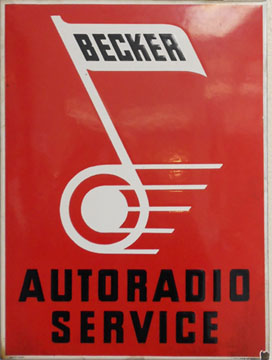 |
The radio sets originally supplied with the Mercedes-Benz Pontons are, like the cars themselves, of another age. The vacuum tubes need to warm up before the sound begins radiating from the speaker. They are prone to needing repeated adjustments, yet the audio quality is warm and inviting. There is something about sitting in a Ponton at night with the radio on, and hearing the barely audible buzz from the power supply that makes one believe if they were to tune the dial to the right frequency, they would hear voices and music from the past. - Jeff Miller / April 5, 2002
Becker and Telefunken were approved suppliers of Mercedes-Benz radios, and the Becker "Mexico" was the top of the line for the Ponton passenger cars of the 1953-1962 period (Service Manual Model 190 / Job No. 82-20). In addition to the radios made by Becker and Telefunken, the factory also approved the subsequent dealership installation of radios made by Blaupunkt and Philips. Even though these other fine German radio manufacturers offered special installation kits, the Mercedes-Benz price lists usually came only with the footnote that "other makes of radio (in addition to Becker and Telefunken) can only be retrofitted at sales and service outlets or authorized agents." It is interesting to note that the radio was typically the most expensive option on the car. In Europe, the FM radio band was 87.5 MHz - 100 MHz up until the mid 1960s when it was expanded to 108 MHz. I have been led to understand that the French police were using the frequencies above 100 MHz until the mid 1960s, thus preventing Germany and other European countries from including those frequencies in their public FM broadcast spectrum. Increasing the FM frequency range to 108 MHz on the early radios is possible, but the lower frequencies will be lost. These were heavy vacuum tube radios which had equally massive power supplies mounted separately under the dash. Also available was a Becker "Reims" adapter for short-wave reception which was attached to the lower portion of the radio under the speaker cabinet. In Europe, parts of Asia and North Africa the long-wave band (150-280 KHz) is used for broadcasting. Radio sets from this part of the world have the LW (long-wave, LF) and the BC (AM or MW) band and the short-wave band in use. The long-wave band is very interesting because long distance reception during the day and DX (very long distance at night) is possible. In America and Australia the long-wave broadcast band was not in widespread use so the car radios built for export did not include it. All of these radios can be used on 6V or 12V by changing the frequency modulator (also known as: "chopper", "buzzer", or "vibrator") and some jumpers on the old G type transformer and by a switch in the later transistor powered supplies. The "vibrator" converts the low (12V) DC car battery voltage to "pulsating DC" which can then drive the primary of a step-up transformer to provide high AC voltage which is then rectified to provide high voltage DC to supply the B+ for the valves (vacuum tubes) which require higher voltage than the car battery could otherwise provide. Around 1958 as technology advanced, the heavy power supplies were first replaced by smaller solid-state transistorized units. In the early 1960s the electronic parts got small enough that the power supply was being included with the tuner and amplifier as a self-contained unit. By 1962 tubes finally disappeared from automobile radio design altogether.
The faceplates on these radios are of different heights and the styling can vary slightly between models with some having a different curve radius at the corners. The fragile Bakelite speaker cabinets used in the sedans with the Blaupunkt and Becker radios are also different from each other. The convertibles and coupés used a wooden speaker cabinet. The barrels of the early radio knobs were metal with a set screw to lock them in place on the shafts of the on/off switch and the tuning dial. The knurled thumbwheel portion of the knob was chromed and finished with a brown Bakelite cap. After 1959, certain radios had black rubberized tuning knobs to match the rest of the dashboard layout. These subtle differences can offer challenges to the Ponton owner who wants to fill the gaping hole in the dashboard with the correct period radio seen at a swap meet or an online auction. The vehicle's data card lists option codes for original factory installed equipment and can help determine the specific radio that came with the car when it was delivered new.
Service and repair is generally not a problem because the vacuum tubes and other electrical components such as resistors, capacitors (condensers) are still available. However; certain parts such as switches must be obtained from donor radios. For more information regarding parts availability and repair see the Links page.
Sams Photofact Sets (schematics and layout photos) are available for some Blaupunkt and Becker models. See caveat about buying photo-copies of schematics online versus making photocopies at your local Public Library.
Before you pay top price (eBay, online vendors, etc.) for photocopies of Sam's Photofact Sets, or Rider Technical Manuals, check your Public Library first. Many libraries still have these documents readily available and will let you make copies for a nominal fee. A photocopy of a typical twelve-page Sam's Photofact Set will cost about $1.50 at your Public Library. |
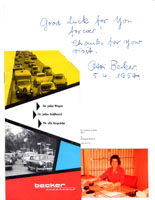
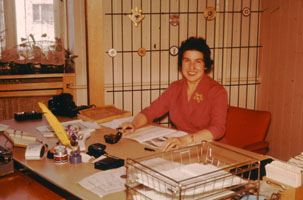

|
Becker "Mexico" AM/FM with automatic signal seeking "Wonderbar" Becker Reims shortwave adapter mounted below the radio  1961 Type 180b owner: Ramzi Saba / Beirut, Lebanon / Photo updated June 6, 2015
See video of Becker Mexico signal seeking mechanism on Links page
Video of Becker Mexico automatic signal seeking Becker Mexico Schematic (all tube version) | |||||||||||||||||||||||||||||||||||||||||||||||||||||||||||||
|
Becker "Europa"
The wood cabinet is from a Type 220S cabriolet. owner: unknown |
Blaupunkt "Stuttgart"
Bakelite cabinet and knobs as found in the four-cylinder models. owner: unknown |
||||||||||||||||||||||||||||||||||||||||||||||||||||||||||||
|
Becker "Europa" High Fidelity 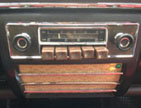
Bakelite cabinet with later knobs / 1961 180b Ponton sedan owner: Ramzi Saba / Beirut, Lebanon
|
Your Ponton Radio Here |
||||||||||||||||||||||||||||||||||||||||||||||||||||||||||||
Blaupunkt "Frankfurt Köln"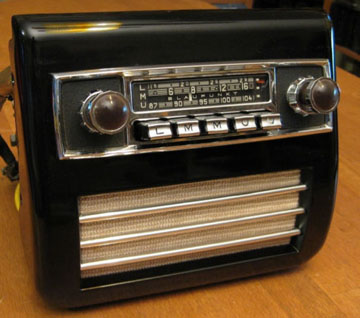 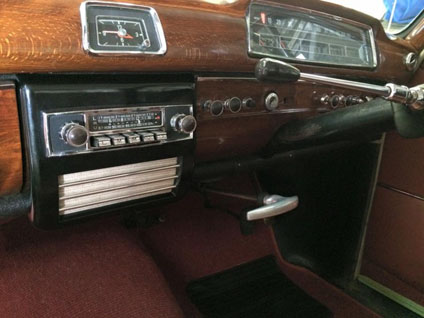 owner: Robert Pearce / 1958 220S sedan (RHD) with Hydrak / Queensland, Australia photo (left) uploaded December 10, 2014 / photo (right) uploaded January 1, 2015 |
|||||||||||||||||||||||||||||||||||||||||||||||||||||||||||||
|
Blaupunkt "Frankfurt" Note the later style plastic knobs. This radio was from an early 1960s Type 180b or 180c sedan |
||||||||||||||||||||||||||||||||||||||||||||||||||||||||||||
|
Courtesy: Gary Kuster / October 22, 2010 |
|
|
|
Telefunken radio from a 1957 Type 190 sedan (European specification).
Note the speaker under the dash. |
|
Becker "Grand Prix" with wood cabinet
1958 Type 220S cabriolet |
Becker "Europa TR"
1958 Type 190SL |
Becker Le Mans Radio and Becker Reims Short-wave AdaptorBecker "Le Mans" radio, power supply, and
Becker "Reims" short-wave adapter.
Becker Le Mans and Reims Schematics
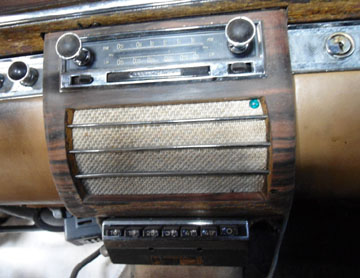 Becker Le Mans with Reims short-wave adaptor in dash Photo (in dash) and schematics uploaded December 22, 2013 |
|
Becker "Mexico TR" with wood cabinet 1957 Type 220S cabriolet |
Blaupunkt (AM band only) with Bakelite cabinet 1960 Type 190b sedan |
Mercedes-Benz Pontons without a radio had a cover for the opening in the dashboard with a model designator badge.
|
Wood cover with model designator badge
Type 220S sedan |
Bakelite cover with model designator badge
1955 Type 180 sedan
(RHD) |
|
Becker Europa II stereo installed in a 1958 220S cabriolet. |
Bakelite radio blank from a 1954 Type 180D right hand drive pickup
|
Wood cover with model designator badge
1955 Type 220a
(RHD) |
Wood cover with model designator badge
1959 220S sedan / owner: unknown |
Ponton Radio Models |
|||||
| Brand | Model | Bands | Features | Price (USD) | Ponton Models |
| Becker | Brescia | AM | signal search tuning "Wonderbar" | $160 | all |
| Becker | Europa | AM/FM/LW | push-button tuning | $130 | all |
| Becker | Europa TG | AM/FM/LW | push-button tuning self-contained solid-state |
all | |
| Becker | Grand Prix | AM/FM/LW | solid-state amplifier / push-button (or) signal search tuning "Wonderbar" | all | |
| Becker | Grand Prix TG | AM/FM/LW | signal search tuning "Wonderbar" and push-button tuning |
all | |
| Becker | Le Mans | AM/LW | signal search tuning "Wonderbar" | $165 | all |
| Becker | Mexico | AM/FM | signal search tuning "Wonderbar" | $173 | all |
| Becker | Mexico IG | AM/FM | solid-state | all | |
| Becker | Mexico TG | AM/FM | signal search tuning "Wonderbar" solid-state |
all | |
| Becker | Monte Carlo | AM/LW | all | ||
| Becker | Monte Carlo TG | AM/LW | self-contained solid-state | all | |
| Blaupunkt | Frankfurt | AM/FM/LW | 5 push-button tuning | all | |
| Blaupunkt | Köln | AM/FM/LW | 3 ridged push-button
(or) "Selectomat" signal search tuning |
all | |
| Blaupunkt | Stuttgart | AM/FM/LW | 5 push-button tuning | all | |
| Reims | adapter | SW | 7 push-button tuning Allowed radios to pick up short-wave bands |
all | |
| Telefunken | II S 61 Selector | $158 | all | ||
Becker and Blaupunkt Radio Schematics |
|
|
Master List of
Becker and Blaupunkt Radio Schematics and Ephemera
Individual .jpg files from the
master list were combined into logical groups, saved as
.pdf files, and zipped. Click the links below to download the
zip files. |
|
| Filename | Size |
| mb_radio_Becker1.zip | 11.2 Mb |
| mb_radio_Becker2.zip | 14.9 Mb |
| mb_radio_Becker3.zip | 10.7 Mb |
| mb_radio_Becker4.zip | 15.8 Mb |
| mb_radio_Becker5.zip | 14.8 Mb |
| mb_radio_Becker6.zip | 11.2 Mb |
| mb_radio_Becker7.zip | 10.0 Mb |
| mb_radio_Blaupunkt1.zip | 12.9 Mb |
| mb_radio_Blaupunkt2.zip | 15.6 Mb |
Radio Installation Instructions |
|
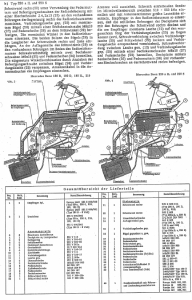
Mercedes-Benz Service Bulletin (German) |
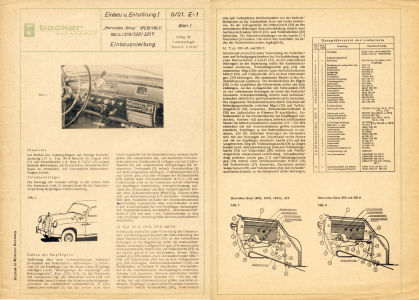
Becker Autoradio Service Bulletin (German) |
|
|
The Becker "Reims" short-wave adapter enabled the Mercedes-Benz Ponton-era radios to receive short-wave bands. The number of tuning push-buttons and their band designations ("16" = 16 meter band, for example) varied from model to model.
Becker Reims (models I-IV) KW-Adapter (short-wave adapter). Radio-Phono Fernseh Katalog 1960-61 (radio-phono television catalog 1960-1961). Original catalog prices are in DM (Deutsche Marks).
- Reims I: 16, 19, 25, 31, 49 meter bands
- Reims II: 16, 19, 25, 41, 60+75, 90+125 meter bands
- Reims III: 19, 25, 31, 49, 60+75, 90+125 meter bands
- Reims IV: 25, 31, 41, 49, 60+75, 90+125 meter bands
 |
The Reims unit has the role of converting the AM ("MW" or "Mittel Welle") radio band into pre-selected SW frequency ranges. My particular Reims unit (which is not shown in these photos) has the following push buttons: 0, T1, T2, 49, 31, 25, 19. When the zero button is pushed, the Reims converter is inactive, and one will be able to tune any station on the AM band. When any other button is pushed, the Reims converts the AM band into SW. Then, fine tuning on the SW bands is done by changing the AM dial knob. This way, one can find SW stations on different meter bands. The different push buttons on the Reims correspond to different SW bands. Fine tuning allows reception of all SW stations which were broadcast on designated waves, for example the Deutsche Welle was on the 49 meter band, and the BBC could be found on the 19 meter band. I do not know what the T1 and T2 buttons mean. I was wondering if they must be pushed together with other buttons. I tried that, but got no results.
 |
The Reims is connected to the radio via the coaxial wire of the antenna. It is connected between the radio and the antenna. It is powered by the radio's power supply. Looking at the power supply, one can see a place to connect the Reims to it. When connected to the power supply, one insures that the Reims will be turned off once the radio is switched off.
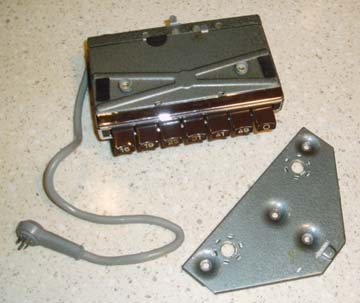 |
I connected the Becker Europa radio to the Reims short-wave converter, and was able to tune into some distant SW stations. I believe it was a great invention for that time, because the listener can shift from one band to the other just by changing the circuitry, thus picking up a different range of signals through the same antenna.
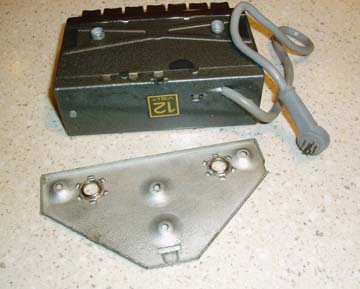 |
As my father told me, short-wave was mainly used in Europe and a bit in the Middle East. But in the 1960s, the AM band (sometimes designated, "MW" or "BC") was the most popular. My 1961 Type 180b Ponton sedan came with the Reims adapter. I believe that was a rare option for a car destined to be used in Lebanon. This justifies the story told to me that my car was purchased from Gargour (Mercedes-Benz agent in Beirut, still in business today) by the US embassy in Lebanon in 1962. I never believed that, but now I think he might have had a point because maybe the US embassy employees would use SW more than ordinary people. Note: When the radio is tuned to the FM, ("LW") the Reims plays absolutely no role.
|
|
The unit was mounted below the speaker cabinet in front of the power supply. In the regions where they were intended to be used, both the power supply and radio tuner have a socket for the Reims short-wave adapter plugs.
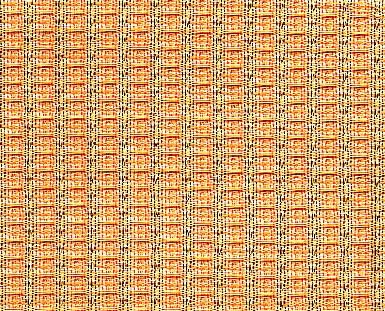 |
Similar vintage radio speaker cloth can be obtained from Becker Autosound. A swatch this size is enough for one radio and costs about $10.00 (December 2014). See the Links page for their website.
Hirschmann Automobile Antennae (Radio-Phono Fernseh Katalog 1960-61) (radio-phono television catalog 1960-1961). Original catalog prices are in DM (Deutsche Marks).
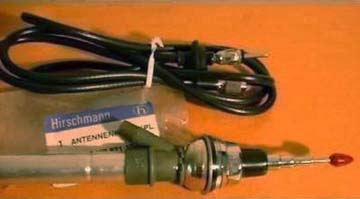 |
Original "red dot" Hirschmann antenna (model "Kofa 200") for 1950s and 1960s German vehicles. Hirschmann was the OEM supplier for Mercedes-Benz, Volkswagen and Porsche (Type 356). These are still available, but expensive. In September 2003, an online auction vendor in Germany set the bidding to begin at $175 USD.
April 30, 2004: Walter Odemer, Co. (Burbank, California), who specializes in Becker, Blaupunkt and other vintage radio repair and sales, sells the Hirschmann red tip antennas (including the motorized version). The SL Auto Haus also sells them. Hint: It really pays to shop and compare prices. See the Links page for contact information. Catalog illustration: Radio-Phono Fernseh Katalog 1960-61. Original catalog prices are in DM (Deutsche Marks).
- Original Factory Accessory Price List / Courtesy: Thomas Mika
- An Introduction to 1950s & 1960s Radios / Wilford Wilkes / November-December 1993 / The Star
- Vacuum Tube Becker Radios / Jim Mahaffey / March-April 2000 / The Star
- July 2004: Ramzi Saba provided much of the narrative regarding the Reims SW adapter
- July 2004: Chris Macha provided close-up photographs of the Reims SW adapter
- Additional recognition goes to Thomas Mika, Ramzi Saba, Thierry Savidan and Graham van Heerden
- Mercedes-Benz Classic magazine (Issue: "1-2004") / Regarding the subsequent dealer installation of radio models made by manufacturers other than Becker
- Radio-Phono Fernseh Katalog 1960-61 / Courtesy: Eager Brothers Music (Bob Havalack) / August 23, 2007
- Sams Photofact data / Courtesy: Phil Langlois (December 20, 1936 - March 16, 2023) / April 19, 2008
- Gary Kuster / Vancouver / April 21, 2009 / Telefunken speaker and power supply configuration / May 2, 2009
- Radio schematics (.jpg format) courtesy: Roland Wilhelm / Barrie, Ontario, Canada / February 8, 2012 / The .jpg files were converted to .pdf and zipped by anonymous / February 9, 2012
- Becker Autoradio Service sign from Ray's Auto Stereo Shop in Sacramento, California courtesy: Matais Bombal / April 25, 2012
- Photos of Becker Autoradio stationery, frau Becker, and Becker Mexico testing courtesy: Kent Emigh / October 2, 2015
- Radio installation illustrations courtesy: Detlef Gonzalez / September 15, 2023